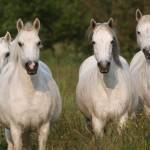Cloning Horses

A dictionary definition indicates a clone is an individual grown from a single body cell of another individual. The new animal is genetically identical to the “parent” cell donor. Previously a subject limited to science fiction tales, cloning of mammals has become a reality in the last few years, with a cloned sheep produced in 1996. Cows, pigs, goats, rabbits, mice, and cats followed, and research continues in this field.
Why would anyone want to clone a horse?
There are several answers to this question. First, there’s a scientist’s desire simply to see if the technology, which was developed using other species, will work for equines. The quick answer is yes.
Second, cloning may prove useful in passing on the genetic material of an exceptional horse that is unable to breed. Champion geldings are an obvious choice, but fertile mares and stallions could also be chosen to start a line of cloned offspring. One of the first foals produced for this reason is a clone of Pieraz, endurance rider Valerie Kanavy’s Arabian gelding. Born in the spring of 2005, this colt should grow up to produce semen that will pass on the physical traits of his champion father. Because a horse’s performance record is based on training and experience as well as genetics, no one can predict how successful the cloned colt will be, either as a performance horse or as a sire of future champions.
Third, the technique might be a way to safeguard populations of endangered equine species such as Przewalski’s horses and Somali wild asses. While cloning does not have the advantage of introducing new genetic material into a small surviving population, it could provide extra copies of individual animals which could be moved to new locations, thus eliminating the possibility that an entire herd could be destroyed by disease or natural disaster.
What is the history of equine cloning?
The first successful U.S. project to produce an equine clone was carried out at the University of Idaho. A cell taken from a 45-day-old mule fetus was used to produce Idaho Gem, a mule foal born in May of 2003, and two more mule clones were born in June and July of the same year. Cloning of a mule was significant because, as sterile hybrids, mules are almost always unable to reproduce on their own.
A few weeks afterward, a team of Italian scientists announced the birth of Prometea, a Haflinger filly that is the first live horse clone.
How is cloning carried out?
Cloning in some other animals has encountered difficulties when using cells from adult animals, possibly because adult DNA has begun to age and deteriorate. For this reason, directors of the Idaho project fused a fetal skin cell with an immature equine egg cell, or oocyte, from which the nucleus (and therefore the genetic material) had been removed. The fetal cells were taken from a pregnant mare that had been bred to a donkey.
Research on cloning has shown that equine oocytes do not mature well under laboratory conditions. Earlier studies at the University of Idaho had suggested higher levels of calcium in the culture medium might stimulate cell division, a change that proved successful as several embryos began to develop. Implanted into the uteruses of surrogate mothers, the embryos developed into three foals that are genetically identical mule triplets.
The Italian cloning team followed a slightly different process, using a skin cell from a mature mare to get genetic material for nuclear transfer into an oocyte. The resulting embryo was implanted into the donor mare, a process that made Prometea a genetically identical copy of her birth mother.
How successful is the process of producing a live cloned foal?
The processes and techniques involved in producing a cloned animal are time-consuming, expensive, and subject to a number of problems. At this stage of research, producing a live foal is not a guaranteed outcome. As an illustration, the Italian team of scientists that announced Prometea’s birth began with more than 800 nuclear-transferred oocytes, of which only 22 developed into embryos at seven days. Of these, 17 were transferred into surrogate mothers, resulting in four pregnancies. Prometea was the only foal carried to term and delivered.
Are the cloned equines developing normally?
The mule foals produced at the University of Idaho were monitored with standard physical exams every three weeks, and full blood chemistry tests were carried out quarterly. No abnormal health or growth problems were found. Now at two years old, the three foals are in excellent health. While Utah Pioneer will stay at the university as a public relations attraction, Idaho Gem and Idaho Star have been leased by officers of the American Mule Racing Association and will enter race training. Their parents are also the parents of Taz, a racing mule with an excellent record at the track. When the cloned mules finish training and begin racing careers, their performance may answer some questions about the practicality of cloning research.
What are the implications for horse breeding?
The Jockey Club, controller of Thoroughbred registrations, will not register cloned horses or allow them to race, and the American Quarter Horse Association has adopted a similar rule. Sports that have no breed restrictions (three-day eventing, for example) may be the best place for cloned horses to demonstrate their abilities. Because of its high cost and uncertain success rate, cloning is not expected to have a large impact on the sport horse market in the immediate future.
How does equine cloning relate to human medicine?
Researchers at the University of Idaho hope that cloning research will shed some light on human age-related diseases and cancer prevention. Studies that help scientists understand the mechanics of cell division and tissue growth could benefit humans, although the results of equine studies are not always applicable to other species.








